Main Page
Catalogs
Collectible
Firearms
And Militaria
For Sale Catalogs
Q&A
Information
Ten Very Uncommon M1903 Rifles
Marks
- Proof
- Rebuild
- Cartouches (Pending)
- M1917 Parts
Inspectors
- Information
- Initials & Dates
- Stamps
Bayonets
- Which
Bayonet?
Dates of Manufacture
- Springfield and all makers (yearly)
- Rock Island (yearly)
- Remington (monthly)
- Smith Corona (yearly)
Variations
- Rod 1903
- USMC 1903
- Sniper
(Pending)
Catalogs
Collectible
Firearms
And Militaria
For Sale Catalogs
Main Page
"Ten Oddball
'03 Springfield Variations"
Courtesy of the Utah Gun Collectors Association's
January 2002 show
Click here for
the Utah Gun Collectors Association site with dozens of great displays
of collectible firearms of all periods.
Copyright 2002 by John
Spangler, all rights reserved
The vast majority of Model 1903 "Springfield"
rifles fit into a few neat categories, and were made in huge numbers for
issue to U.S. military troops. However, a few oddball designs were
made, or have been altered, that inspire collectors to keep searching
for more neat toys for their collection.
- Model 1901 predecessor to the M1903 rifle (unfinished receiver only)
- Model 1903 rifle with rod bayonet (all but a few hundred were later modified to take the knife bayonet)
- Model 1903 rifle in .22 caliber for training (known as the Hoffer-Thompson)
- Model 1903 National Match Special- one of about 150 made with special stocks
- Model 1903A1 rifle marked "ROCK ISLAND ARSENAL but actually made at Springfield
- Model 1903A2 rifle for use in artillery sub-caliber device
- Model 1903A3 National Match rifle- one of 140 made before they realized the design was worthless.
- Model 1903 NRA Sporting rifle, used as the basis for a classic 1930s style sporting rifle.
- Model 1937 "Bannerman" Springfield made from salvaged scrap parts from many different types of rifles.
- Mann Accuracy Barrel, assembled to M1903A3 action for testing ammunition accuracy.
A few of the rifles in this display. See details below.
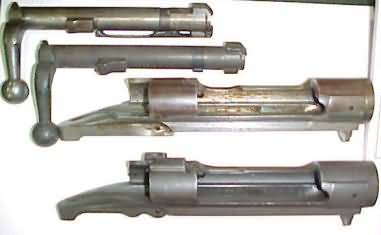
"In the Beginning..."
Model 1901 Receiver and Bolt (unfinished) The Model 1903 Springfield
had its origins in experimental models based on the Mauser rifles encountered
in the Spanish American War of 1898. Trials in 1901 seemed very successful,
and Springfield believed that the Model 1901 rifle would be approved
for manufacture. They unofficially begin production of some parts. Unfortunately,
the Ordnance Department decided changes were needed, and the parts being
made had to be scrapped. Occasionally these will be encountered assembled
into complete M1903 style rifles, but as they were never heat-treated,
they would be very dangerous to fire. Here are an unfinished receiver
and bolt from the Model 1901 rifle, which closely resemble the Model
1903. Note that the "safety lug" on the bolt is a bit lower, and that
the rear "bridge" of the receiver lacks the raised step found on the
1903 rifles. The left wall of the receiver has a deep cut for thumb
clearance when loading with stripper clips, and a longer reinforcement
on the side. The 1901 parts turn up from time to time, but were unfinished
scrap, and rifles built using them are not safe to fire.

The Original .30 caliber cartridge, Model of 1903 (top) with heavy round
nose bullet and case about 0.10 inch longer than the .30 caliber cartridge
Model of 1906 (.30-06) shown below. About the same time that the rod
bayonet rifles were being converted for the knife bayonet, they were
also being altered for the much better .30-06 cartridge.
.
 .
.
"As poor an invention as I ever saw..."
Model 1903 Springfield with Rod Bayonet
The 1903 Springfield as originally adopted used a "rod bayonet" and a .30-caliber Model 1903 cartridge (".30-03") with a 220 grain round nose bullet. Approximately 74,500 rifles were finished by the end of 1904 and being issued to the Army. However, on January 5, 1905 President Theodore Roosevelt wrote the Secretary of War "I must say that I think that ramrod bayonet is about as poor an invention as I ever saw." Production stopped immediately. The offending rod bayonet was eliminated and a knife bayonet, similar to the previous Krag bayonet was adopted. Since the Model 1903 rifle was shorter than the Krag, the M1903 used longer bayonets to have about the same "reach". Just as the bayonet fiasco was being corrected, it was decided that the .30-03 cartridge had serious problems, so a 150 grain pointed bullet in a shorter case was adopted in 1906. The .30 caliber cartridge, Model of 1906, known simply as the ".30-06" was born. All rifles had to be modified for the new cartridge and bayonet before being issued, resulting in chaos in the Armories until about 1909. Probably less than 100, perhaps as few as 50 original rod bayonet M1903 Springfields remain, along with a similar number of rifles like this one which have been restored to their original appearance.
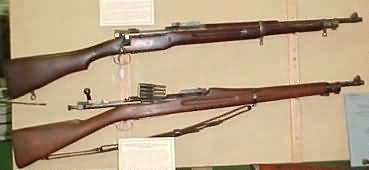 .
.
Top- "Bannerman" rifle, below- Hoffer Thompson rifles.
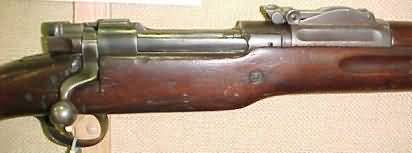
Salvaged scrap sold to suckers...
"Bannerman Special Model 1937" Springfield Rifle
Francis Bannerman Sons was a famous surplus dealer located
in New York, operating from shortly after the Civil War until the 1960s.
After decades of accumulating huge quantities of surplus parts and trying
many clever improvisations, they managed to make complete rifles to
be sold at very low prices to cash strapped buyers at the end of the
depression. "Low number" Model 1903 receivers being scrapped as potentially
unsafe were fitted with barrels of unknown origin. Model 1917 bolts,
stocks, and trigger guards were modified slightly to fit. Krag rear
sights were welded to early M1903 rear sight bases and shimmed on the
barrels. Assorted bands and swivels were used. Very ingenious and profitable,
these are probably the oddest of all the 1903 rifles here.

A .22 caliber version of the .30 caliber rifle...
Gallery Practice Rifle, caliber .22, Model of 1903 "Hoffer-Thompson"
Rifle practice was important training for all soldiers.
Weather and distance to ranges suitable for use of .30-06 ammunition
made practice nearly impossible for many units. However, most had access
to indoor ranges where .22 caliber rimfire rifles could be used. Besides
aiming skills, an important goal was to teach use of the stripper clip
for reloading the rifle, and bolt manipulation. Therefore, the Army
desired a .22 caliber rifle that was as close to the Model 1903 service
rifle as possible. Two Ordnance officers, Jay Hoffer and John T. Thompson
(best known for his later invention, the Thompson sub machine gun, or
"Tommy Gun") came up with a solution. Their version of the M1903 rifle
used a .22 caliber barrel, and special steel adapters shaped like a
.30-06 cartridge but holding a .22 caliber short cartridge. This design
worked well enough, but by 1922 it was decided that the "stripper clip"
practice was not necessary, and simpler .22 caliber training rifles
were adopted. 15,525 were made circa 1907-1918, but most of the "Hoffer-Thompson"
rifles were reworked with standard .30-06 barrels and returned to service
rifle use. Surviving examples are quite scarce.
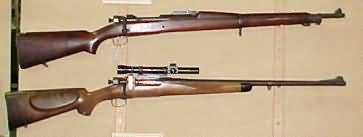
Top- Model 1903A1 rifle marked Rock Island but actually made at Springfield, below M1903 NRA Sporter- sporterized
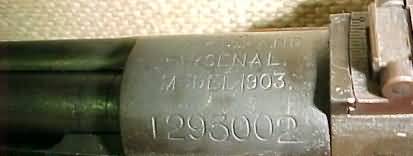
Don't believe everything you read....
M1903A1 Rifle Made at Springfield but marked Rock Island
Rock Island Arsenal made Model 1903 rifles from 1906 to 1913, and 1917 to1919. Later, all unfinished parts were shipped to Springfield. Among these parts were about 2,000 receivers that were nearly finished, and had already been marked " ROCK ISLAND ARSENAL" but not serial numbered or heat treated. About 1928 Springfield finished these parts, and made them into complete rifles, but left the Rock Island markings in place. Clearly marked ROCK ISLAND ARSENAL, but Rock Island only made rifles up into the low 400,000 range.

Sporting rifles for NRA members...
"U.S. Rifle, Model 1903, Sporting type, star gauged. fitted with Lyman
48 Receiver sight"
High quality Model 1903 rifles with specially selected
"star gauged" barrels and the "NRA style" stock were offered for sale
to NRA members circa 1924-1938, ostensibly because of a lack of commercial
sporting rifles on the market at the time. (The Winchester Model 54
and 70 and the Remington Model 30 were introduced during that period).
5,538 NRA Sporters were made. NRA Sporter rifles were sometimes left
in their original configuration, sometimes crudely adapted to the owner's
preferences, and sometimes used as the basis for beautiful custom rifles.
This is an example built into a classic 1930s style rifle with a Griffen
& Howe mount and Lyman Alaskan scope. It was made for a left handed
shooter, so it has the cheekpiece on the "wrong" side of the stock!
Although not "original" it shows how the NRA Sporter rifles met the
needs of their owners, although it pretty well destroyed it for the
collector of Springfield Armory rifles.
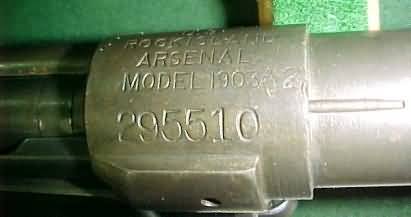
The missing link...
Model 1903A2 Rifle (Subcaliber Device)
Artillery, tank guns and anti-tank weapons training used
very expensive ammunition and required extremely large ranges for obvious
safety reasons. By using a "sub-caliber" device in the cannon to fire
rifle caliber ammunition, training could be conducted on regular rifle
ranges available at most Army posts. This was essentially a standard
rifle action bolted into an adapter to fit into the cannon barrel. Around
1935-1940, an estimated 1,000 Model 1903 rifles had the stock assembly
and front and rear sights removed, and the trigger staked in place,
and were designated Rifle, Model 1903A2, to be kept specifically for
sub-caliber use. Some were marked with the "A2" marking, but not all.
By the end of WW2, the sub-caliber use was abandoned and most of the
Model 1903A2 rifles were rebuilt into regular service rifles. Most collectors
are familiar with the M1903A1 and M1903A3 rifles, but have never seen
the M1903A2. Most were later rebuilt and issued as standard infantry
rifles.

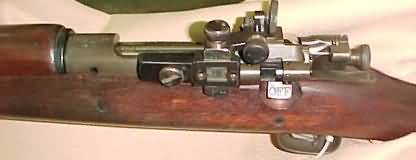
The Unmatched Match Rifle (Oops!)
Model 1903A3 National Match
National Match competition resumed in 1953 after interruptions
by WW2 and the Korean War, but no National Match rifles had been made
since the 1930s. Popular belief was that the M1 Garand could never be
made into a match grade rifle. Therefore, Ordnance Officers hoped that
some of the thousands of unissued M1903A3 rifles on hand could be easily
converted for use as National Match grade rifles. Only 140 out of
a planned 200 rifles were modified in 1954, when it was pointed
out that the basic design was useless! Although using the finest micrometer
target sights available, the specified mounting location allowed the
choice of two sight positions. In one, the sight interfered with bolt
operation. The other prevented use of stripper clips needed for loading
during rapid fire. Springfield engineers quickly (and quietly) stopped
this project before embarrassing themselves further.
 .
. 
A rifle that is not a rifle...
Model 1903 Mann Accuracy Barrel
M1903 rifle actions have periodically been used with special
accuracy barrels. In this case, it is a Remington made M1903A3 receiver.
Remington also made the barrel, but about 25 years after the receiver
was made. The bolt, serial numbered to the receiver, was made by Smith
Corona, a mixture sure to irritate collectors. However, this is exactly
what was assembled to meet military specifications. Manufacture of military
ammunition includes a requirement that it meets certain accuracy standards.
Special barrels, made to extremely tight tolerances, and held in special
fixtures are used under controlled conditions for the accuracy tests.
Since the "rifle" is held by the barrel rests, there is no need for
a conventional stock.
[photo to be added later]
Very Special rifles...
Model 1903 "National Match Special"
Huge stockpiles of rifles left after WW1 allowed Springfield
Armory designers to devote attention to rifles for training, competition,
and even sporting use during the 1920s. The Model 1922 .22 caliber rifle
introduced the excellent "NRA Style" stock, with a full pistol grip,
higher comb, and large "shotgun style" buttplate. In 1924 a variation
of this stock, but with regular full length forend was offered as an
option on specially made National Match rifles. Only about 150 of these
higher priced "National Match Special" rifles were sold.

Another oddball tidbit. The "spare parts container" carried in
many rifles from about 1911 to 1917. This wooden case had slots
for a firing pin, cocking piece and extractor, and was carried instead
of the nickel plated brass oiler and thong case. A very scarce accessory,
and most people would not recognize if they had one.
Copyright 2002 by John
Spangler, all rights reserved
Updated 28 December 2002
